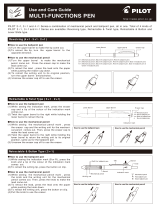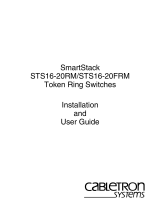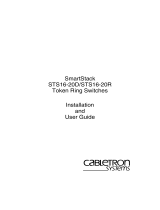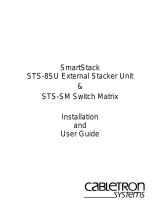
3 Function BRFS/BRDS-17
3.1 Overcurrent protection
3.2 Thermal protection
3.3 Remote ON / OFF
3.4 Remote sensing
3.5 Adjustable voltage range
3.6 Softstart/Start-up sequence
3.7 Power good
3.8 Sequence
3.9 PMBus communication
4 Series and Parallel Operation BRFS/BRDS-20
5 Cleaning BRFS/BRDS-20
6 Storage method BRFS/BRDS-21
BRFS/BRDS-17
BRFS/BRDS-17
BRFS/BRDS-17
BRFS/BRDS-18
BRFS/BRDS-18
BRFS/BRDS-19
BRFS/BRDS-19
BRFS/BRDS-20
BRFS/BRDS-20
1 Connection for Standard Use BRFS/BRDS-16
2 Wiring Input / Output Pin BRFS/BRDS-16
2.1 Wiring input pin
2.2 Wiring output pin
BRFS/BRDS-16
BRFS/BRDS-17
4.1 Series operation
4.2 Parallel operation
BRFS/BRDS-20
BRFS/BRDS-20
7 Safety Considerations BRFS/BRDS-21
8 Temperature Measurement Location BRFS/BRDS-21
9 Package Information BRFS/BRDS-22
DC-DC Converters POL Type Instruction Manual
BRFS/BRDS-15
June 26, 2020

1
Connection for Standard Use
¡In order to use power supply,it is necessary to wire as shown in
Fig.1.1 and Fig.1.2.
Ci
+VIN
SGND
F1
RC
GND
+VOUT
TRM
+S
-S
R
TRM
DC
input Load
*SGND is connected to GND inside the power supply.
*Short the -S and GND only BRDS40/60S.
Fig.1.1 Connection for standard use of BRFS30/40/60S-BRDS40/60S
Ci
+VIN
F1
RC
GND
+VOUT
+TRM
-TRM
+S
-S
R
TRM
DC
input Load
Fig.1.2 Connection for standard use of BRFS60/100/120/150-
BRDS60/100/120/150
Reference 3 "Wiring Input/Output Pin"
8
Temperatuve measurement points
¡Short the following pins to turn on the power supply.
¿ BRFS30/40/60S
SGND RC, +VOUT +S
¿
BRFS60/100/120/150-BRDS40/60/60S/100/120/150
GND RC (SGND RC of BRDS40), +VOUT +S, GND -S
Reference 3.3 "Remote ON/OFF"
3.4 "Remote sensing"
¡Connect resistance to set the output voltage as below.
¿ BRFS30/40/60S-BRDS40/60S
GND TRM
¿
BRFS60/100/120/150-BRDS60/100/120/150
+TRM -TRM
Reference 3.5 "Adjustable voltage range"
¡Between input and output is not isolated .
¡The BRFS/BRDS series handle only the DC input.
Avoid applying AC input directly.
It will damaged the power supply.
Table 1.1 External parts
No. Parts Reference
1 F1:Fuse
2.1(1)
External fuse
2 Ci:External output capacitor
2.1(2)
External input capacitor
3RTRM:Resistance for adjustment
output voltage
3.5
Adjustable voltage range
2
Wiring Input/Output Pin
2.1 Wiring input pin
(1) External fuse
¡Fuse is not built-in on input side. In order to protect the unit, install
the normal-blow type fuse on input side.
Table 2.1 Recommended fuse (normal-blow type)
Model
BRFS30/40-
BRDS40
BRFS60/60S-
BRDS60/60S
BRFS100-
BRDS100
BRFS120-
BRDS120
BRFS150-
BRDS150
Rated
current 40A 60A 80A 100A 125A
¡When the input voltage from a front end unit is supplied to multiple
units, install the normal-blow type fuse in each unit.
¡When the fuse is open, power good signal is not outputed.
(2) External capacitor on the input side
¡Install an external capacitor Ci, between +VIN and GND input pins
for low line-noise and for stable operation of the power supply.
Use ceramic capacitors for the external capacitor Ci.
Table2.2 Recommended external input capacitor(Ceramic)
Model Recommended Ci
Vin=5V Vin=12V
BRFS30/40/60S-BRDS40/60S 8×22mF 4×22mF
BRFS60/100-BRDS60/100 8×22mF 4×22mF
BRFS120/150-BRDS120/150 2×22mF 2×22mF
¡Ci is within 5mm for pins. Make sure that ripple current of Ci is
less than its rating.
¡When an impedance and inductance level of the input line become
higher, the input voltage may become unstable. In that case, the
input voltage becomes stable by increasing Ci.
¡Note that the input voltage may increase due to the regenerative
operation of the power supply, when starting up with residual volt-
age in the output or when the output voltage is sharply reduced
using the SEQ pin or TRM pin.
(3) Recommendation for noise-lter
¡Install an external input lter as shown in Fig.2.1 in order to re-
duce conducted noise. Ci is shown in Table 2.2.
C1
L
1
F
1
Ci
+VIN
GND
DC
input
C1 :220mF(BRFS30)
:470mF( BRFS40/60/60S/100/120-
BRDS40/60/60S/100/120)
:3×470mF(BRFS150-BRDS150)
L1 :0.3mH
Fig.2.1 Example of recommended external input lter
DC-DC Converters POL Type Instruction Manual
BRFS/BRDS-16 June 26, 2020

(4) Reverse input voltage protection
¡Avoid the reverse polarity input voltage. It will damage the power
supply.
It is possible to protect the unit from the reverse input voltage by
installing an external diode as shown in Fig.2.2.
+VIN
GND
DC IN
Fig.2.2 Reverse input voltage protection
2.2 Wiring output pin
¡When the BRFS/BRDS series supplies the pulse current for the
pulse load, please install a capacitor Co between +VOUT and
GND pins.
+ VOUT
Co
GND
Pulse
Load
Fig.2.3 wiring external output capacitor
Table 2.3 Recommended Capacitor and max Co (Ceramic)
Model
Recommended Co
MAX Co
BRFS30/40/60S-BRDS40/60S 3×100mF 10,000mF
BRFS60-BRDS60 2×100mF 10,000mF
BRFS100-BRDS100 4×100mF 20,000mF
BRFS120/150-BRDS120/150 4×100mF 10,000mF
¡Use ceramic capacitors for the external capacitor Co.
Contact us when using other than ceramic capacitors.
¡The output ripple voltage may grow big by resonance with Co and
ESL of the wiring, if resonance frequency and switching frequency
are close.
¡Ripple and Ripple Noise are measured, as shown in the Fig.2.4.
Co0, Co1, Co2 and Co3 is shown in Table 2.4.
+VOUT
GND
50mm
+VIN
GND
Co2
Oscilloscope R
C
BW:20MHz
Co3 Co4Co1
1.5m 50W
Coaxial cable
R=50W
C=4700pF or 10000pF
1mm
Co0
1mm 1mm1mm
Load
DC
input
Fig.2.4 Measuring method of Ripple and Ripple Noise
Table 2.4 Co0, Co1, Co2 and Co3 which is used in measuring
No. Model Co0 Co1 Co2 Co3 Co4
1
BRFS30/60S-BRDS60S
- -
100mF 100mF 100mF
2 BRFS40-BRDS40
100mF
-
100mF 100mF 100mF
3 BRFS60-BRDS60
---
100mF 100mF
4BRFS100/120/150-
BRDS100/120/150
-
100mF 100mF 100mF 100mF
3 Function
3.1 Overcurrent protection
¡Over Current Protection (OCP) is built-in and works over 105% of
the rated current or higher. However, use in an overcurrent situa-
tion must be avoided whenever possible.
The output voltage of the power module will recover automatically
when the fault causing overcurrent is corrected.
When the output voltage drops after OCP works, the power mod-
ule enters a ”hiccup mode” where it repeatedly turns on and off at
a certain frequency.
3.2 Thermal protection
¡When the power supply temperature is kept above 120C, the
thermal protection will be activated and simultaneously shut down
the output.
The output voltage of the power supply will recover automatically
when the unit is cool down.
3.3 Remote ON/OFF
¡The remote ON/OFF function is incorporated in the input circuit
and operated with RC and GND. If positive logic control is re-
quired, order the power supply with “-R” option.
Table3.1 Specication of Remote ON/OFF
ON/OFF
logic Between RC and GND Output
voltage
Standard Negative L level(-0.2 - 0.6V) or short ON
H level(3.0 - VIN) or open OFF
Optional -R Positive L level(-0.2 - 0.6V) or short OFF
H level(3.0 - VIN) or open ON
*Source current from RC pin is 0.5mA(max).
¡When remote on/off function is not used, please short GND and
RC.
SW
RC
RC
RC
GND
GND
Transistor
External
Power supply
(a ()b)
(c ()d)
GND
VCC
( Vin)
I C
DC
input
DC
input
+VIN
RC
GND
+VIN
Fig.3.1 RC connection example
DC-DC Converters POL Type Instruction Manual
BRFS/BRDS-17
June 26, 2020

BRFS30
BRFS40/60S/120/150
-
BRFS60/100
-
BRDS40/60S/120/150
BRDS60/100
RTRM =[kW]
8
VOUT-0.8
RTRM =[kW]
12
VOUT-0.6
RTRM =[kW]
14
VOUT-0.7
Table 3.2 Calculation result of
BRFS30
Table 3.3 Calculation result of
BRFS40/60S/120/150-
BRDS40/60S/120/150
No VOUT RTRM No VOUT RTRM
1 0.8 OPEN 1 0.6 OPEN
2 1.0 40.0kW2 1.0 30.0kW
3 1.2 20.0kW3 1.2 20.0kW
4 1.5 11.429kW4 1.5 13.3kW
5 1.8 8.0kW5 1.8 10.0kW
6 2.5 4.706kW
7 3.3 3.2kW
Table 3.4 Calculation result of
BRFS60/100-
BRDS60/100
No VOUT RTRM
1 0.7 OPEN
2 1.0 46.6kW
3 1.2 28.0kW
4 1.5 17.5kW
5 1.8 12.7kW
+VOUT
GND
TRM
R
TRM
+VOUT
GND
+TRM
R
TRM
-TRM
LoadLoad
Fig.3.4 Connecting BRFS30/40/60S
Fig.3.5 Connecting BRFS60/100/120/150
-
BRDS40/60S
-
BRDS60/100/120/150
¡The output voltage should be set within the range of Figure 3.6
(only BRFS150-BRDS150).
¡If it deviates from the range, the output voltage turns off.
4.5
7.0
1.1 1.80.6
Output voltage [V]
Input voltage [V]
14.0
Operating area
Fig.3.6 Operating area
3.4 Remote sensing
(1) When the remote sensing function is not in use
+S
+VOUT
-
S
GND
LOAD
Short at pin root
Fig.3.2 Connection when the remort sensing is not in use
¡When the remote sensing function is not in use, it is necessary to
conrm that pins are shorted between +S & +VOUT and between
-S & GND.
¡Wire between +S & +VOUT and between -S & GND as short as
possible.
Loop wiring should be avoided.
This power supply might become unstable by the noise coming
from poor wiring.
(2) When the remote sensing function is in use
GND
+S
Load
-S
+VOUT
Wire as close as possible
Fig.3.3 Connection when the remote sensing is in use
¡Twisted-pair wire or shield wire should be used for sensing wire.
¡Thick wire should be used for wiring between the power supply
and a load.
Line drop should be less than 0.5V.
Voltage between +VOUT and GND should remain within the out-
put voltage adjustment range.
¡If the sensing patterns are short, heavy-current is drawn and the
pattern may be damaged.
The pattern disconnection can be prevented by installing the pro-
tection parts as close as a load.
¿ -Y1
This is change the open loop characteristics accelerated while using
remote sensing with a large external capacitor on the output side.
For more information please contact us.
3.5 Adjustable voltage range
¡Output voltage is adjustable by the external resistor.
¡The temperature cofciect could become worse, depending on the
type of a resistor.
Resistor.....Metal lm type, coefcient of less than ±100ppm/C
¡When TRM is opened, output voltage is adjusted to the minimum.
¡RTRM is calculated in the following expressions.
DC-DC Converters POL Type Instruction Manual
BRFS/BRDS-18 June 26, 2020

3.6 Softstart/Start-up sequence
¡The adjustment of the rise time is possible by connecting CSEQ.
GND
SEQ
RC
OFFON
CSEQ
Fig.3.7 Example of soft start circuit
¡When the voltage is applied to the terminal SEQ, the output volt-
age tracks this voltage until the output reaches the set-point volt-
age. SEQ terminal voltage vs output voltage is calculated the fol-
lowing formula.
Avoid SEQ terminal voltage is set below the set voltage output by
Rtrm, the output voltage does not rise to set output voltage. Maxi-
mum applicable voltage of terminal SEQ is Vin.When the function
is not used, open terminal SEQ.
CSEQ [mF] = (0.284 ÷ Vo[V]
-
0.06) × T[ms]
(0.6V [ Vo [ 2.0V)
CSEQ [mF] = (0.284 ÷ Vo[V]
-
0.047) × T[ms]
(2.0V < Vo [ 3.63V only BRFS30)
SEQ
VOUT
Setting VOUT
Fig.3.8 SEQ > Vout setting
VOUT
Setting SEQ
VOUT
Fig.3.9 SEQ < Vout setting (not recommended)
¡With the voltage to input into SEQ pin, you can control a start se-
quence of plural power supplies.
(a) The same time
R
A
+VOUT A +VOUT B
P.S. A P.S. B
SEQ
GNDGND
RCRC
+VOUT A
+VOUT B
V
RC
A
V
t
(b) The same voltage
+VOUT A +VOUT B
SEQ
GNDGND
V
RCRC
t
+VOUT A
+VOUT B
V
RC
A
R
A
P.S. A P.S. B
(c) The time lag
+VOUT A +VOUT B
RC
GNDGND
SEQ
RC
+VOUT A
+VOUT B
V
RC
A
V
t
P.S. A P.S. B
Fig.3.10 Example of sequence control
¡If this function is unnecessary, please make SEQ pin open.
¡It is not possible to shorten the rise time when not using this func-
tion.
3.7 Power good
¡By using PGOOD, it is possible to monitor power supply whether
normal operation or abnormal operation.
¡PGOOD circuit is designed as shown in Fig.3.11.
Sink current of PGOOD is 10mA max.
DC-DC Converters POL Type Instruction Manual
BRFS/BRDS-19
June 26, 2020

maximum 10%, the total output current must not exceed the value
determined by the following equation.
(Output current at parallel operation)
=(the rated current per unit)×(number of unit)×0.9
BRFS/BRDS
Master
BRFS/BRDS
BRFS/BRDS
+VIN
+VIN
+VIN
GND
+VOUT
+VOUT
+VOUT
VOUT
Adjustmen
t
VI VOUN T
+TRM
-TRM
+TRM
-TRM
+TRM
-TRM
SH
SYNC
*1
ARE
GND
SH
SYNC
*1
ARE
GND
SH
SYNC
*1
ARE
Rtrm
Rtrm
Rtrm
Slave
Slave
100
W
or less
+S
-S
+S
-S
+S
-S
*1 Only BRDS60S
In case of BRFS120/150 and BRDS120/150, please contact us
Fig.4.1 Example of wiring method in parallel operation
¡Make power supply from the same input power supply.
¡Total number of units should be no more than 5 pieces.
¡PGOOD of slave power supply output the operating conditions.
When power supply is in operation, PGOOD output high level.
At the time of stop, it output low level.
¡Please connect each other’s SEQ pins if you use SEQ pin.
¡Voltage drop from a power supply to the sensing point should be
less than 0.2V for stable control.
¡Only use RC pin of the master power supply, RC pin of the slave
power supply should be short to GND.Or let RC pin’s of the master
power supply and the slave power supply short, and please use it.
¡If this function is unnecessary, please make SHARE pin open.
¡In parallel operation, please use a single model together. When it
is necessary to use different model together, please contact us.
¡In the case of stop using the SEQ function in parallel operation,
the power supply will immediately stop when SEQ terminal voltage
is below the output voltage set by the RTRM.
¡Do not connection external clock to the SYNC pin.
5 Cleaning
¡When cleaning is necessary, clean under the following conditions.
Method : Varnishing, ultrasonic wave and vapor
Cleaning agents : IPA (Solvent type)
Total time : 2 minutes or less
¡Do not apply pressure to the lead and name plate with a brush or
scratch it during the cleaning.
¡After cleaning, dry them enough
PGOOD 5V
GND
Fig.3.11 Internal PGOOD circuit
¡Voltage of PGOOD pin become low when over current protection
circuit is work, or output voltage is different from a set point more
than ±12.5%.
¡If this function is unnecessary, please make PGOOD pin open.
3.8 Sequence
¡Fig.3.12 is a sequence chart of each function of BRFS/BRDS.
PGOOD
OUTPUT
INPUT
RC
RC:ONRC:OFF
6.3ms(typ)
Start up
voltage
Power supply start
over current
1.2s(typ)
6.3ms(max)
Fig.3.12 Sequence chart of BRFS/BRDS
3.9 PMBus communication
¡PMBus communication is possible BRDS series.
For more information please contact us.
4
Series and Parallel Operation
4.1 Series operation
¡Series operation is not possible.
4.2 Parallel operation
¡Parallel operation is possible BRFS60/100/120/150-BRDS series
(BRFS30/40/60S is not possible). BRFS40/60S has a parallel op-
eration “P”.
¡In parallel operation, wiring as Fig.4.1
¡Make the +S and -S of the slave power supply unconected.
¡To improve the load sharing of each unit, use the same length and
same wire size from each unit to the load.
¡As variance of output current drew from each power supply is
DC-DC Converters POL Type Instruction Manual
BRFS/BRDS-20 June 26, 2020

6 Storage method
¡To stock unpacked products in your inventory, it is recommended
to keep them under controlled condition, 5-30C, 60%RH and use
them within a year.
¡24-hour baking is recommended at 125C, if unpacked products
were kept under uncontrolled condition, which is 30C, 60%RH or
higher.
Original reels are not heat-resistant. Please move them to heat-
resistant trays in preparation to bake.
To check moisture condition in the pack, silica gel packet has
some moisture condition indicator particles.
Indicated blue means good. Pink means alarm to bake it.
¡The reels will be deformed and the power supply might be dam-
aged, if the vacuum pressure is too much to reseal.
7 Safety Considerations
¡To apply for safety standard approval using this power supply, the
following conditions must be met.
¿
This unit must be used as a component of the end-use equipment.
¿Safety approved fuse must be externally installed on input side.
8
Temperature
Measurement Location
¡Make sure the temperatures measurement locations shown from
Fig.8.1 to Fig.8.2 below are on or under the derating curve in “De-
rating”.
Ambient temperature must be kept at 85C or under.
Temperature measurement location
Point A Point B
Fig.8.1 Temperature measurement location (BRFS30)
Temperature measurement location
Point A
Fig.8.2 Temperature measurement location (BRFS40-BRDS40)
Temperature measurement location
Point A
Fig.8.3 Temperature measurement location (BRFS60S-BRDS60S)
Temperature measurement location
Point A Point B
Fig.8.4 Temperature measurement location (BRFS60-BRDS60)
Temperature measurement location
Point A Point B
Fig.8.5 Temperature measurement location (BRFS100-BRDS100)
DC-DC Converters POL Type Instruction Manual
BRFS/BRDS-21
June 26, 2020

9 Package Information
¡Please refer to a Fig.9.1 to Fig.9.4 for Package form (Reel).
¡The packed number is 200 (BRFS30/40/60S-BRDS40/60S),
100 (BRFS60/120-BRDS60/120), 80 (BRFS100/150-
BRDS100/150).
hModel
BRFS30
BRFS60S
-
BRDS60S
BRFS40-BRDS40
10.0
13.2
11.5
2±0.15
0.5±0.05
4±0.1
1.5
1.7
56.0±0.3
52.4±0.1
1.75±0.1
26.2±0.1
h±0.1
20±0.1
R0.75
+0.2
-0
14.2
+0.2
-0
33.7
+0.1
-0
f
1.5
A
B
B
A
B-B cross section
A-A cross section
Fig.9.1 Taping dimensions of BRFS30/40/60S-BRDS40/60S
1.5
0.5±0.05
h±0.1
26.2±0.1
2±0.15
4±0.1
1.7
56.0±0.3
52.4±0.1
1.75±0.1
32±0.1
R0.75
+0.2
-0
23.6
+0.1
-0
f
1.5
+0.2
-0
33.7
B-B cross sectio
n
A-A cross section
B
A
B
A
hModel
BRFS60/120
-
BRDS60
BRFS120
-
BRDS120
10.0
13.0
Fig.9.2 Taping dimensions of BRFS60/120-BRDS60/120
Temperature measurement location
Point A Point B
High heat radiation terminal option is available (optional : L).
Fig.8.6 Temperature measurement location (BRFS120-BRDS120)
Temperature measurement location
Point A Point B
High heat radiation terminal option is available (optional : L).
Fig.8.7 Temperature measurement location (BRFS150-BRDS150)
DC-DC Converters POL Type Instruction Manual
BRFS/BRDS-22 June 26, 2020

A
B
B
A
38.6
1.7
1.5
28.3
h
±
0.1
R0.75
+0.2
-
0
+0.2
-
0
0.5± 0.05
+0.1
-
0
f1.5
36±0.1
2±0.15
4±0.1
26.2 ± 0.1
56.0 ± 0.3
52.4 ± 0.1
1.75 ±0.1
B-B cross sectio
n
A-A cross section
hModel
BRFS100-BRDS100
BRFS150-BRDS150
10.0
14.0
Fig.9.3 Taping dimensions of BRFS100/150-BRDS100/150
W2
W1
Hub Diameter
f330±2
f13±0.2
Model
Tape Width
[mm]
Hub
Diameter
[mm]
W1
[mm]
W2
[mm]
BRFS30/40/60S-
BRDS40/60S
56 100 57.4±1.0 61.4±1.0
BRFS60/120-
BRDS60/120 56 150 57.5±1.0 61.5±1.0
BRFS100/150-
BRDS100/150 56 150 57.5±1.0 61.5±1.0
Fig.9.4 Reel dimensions
¡Please refer to specications for the details of package informa-
tion
DC-DC Converters POL Type Instruction Manual
BRFS/BRDS-23
June 26, 2020
-
 1
1
-
 2
2
-
 3
3
-
 4
4
-
 5
5
-
 6
6
-
 7
7
-
 8
8
-
 9
9
Ask a question and I''ll find the answer in the document
Finding information in a document is now easier with AI
Related papers
Other documents
-
 Pilot Communications 2+1 Series User guide
Pilot Communications 2+1 Series User guide
-
 Cabletron Systems SmartStack STS16-20FRM Installation and User Manual
Cabletron Systems SmartStack STS16-20FRM Installation and User Manual
-
 Cabletron Systems SmartStack STS16-20R User manual
Cabletron Systems SmartStack STS16-20R User manual
-
 Olicom CrossFire 8600 User manual
Olicom CrossFire 8600 User manual
-
Analog Devices ADP1148-3.3 User manual
-
Daewoo DTC-2132 series User manual
-
Texas Instruments LM5175 4-Switch Buck-Boost Converter High Density EVM User guide
-
 Cabletron Systems SmartStack STS-8SU Installation and User Manual
Cabletron Systems SmartStack STS-8SU Installation and User Manual
-
DAEWOO ELECTRONICS DSC-3220E/3220L User manual
-
Texas Instruments TPS548A20 EVM User guide













